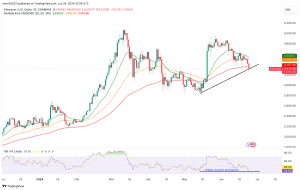The Ethereum price is exchanging hands at $3,221 after dropping more than 5% over the last 24 hours.
ETH experienced a 9% drop over the last 48 hours as its price dropped from a high of $3,519 on June 23 to an intra-day low of $3,233, levels last seen on May 20.
The flash downswing resulted in liquidations of more than $59.67 million worth of ETH futures, which were leveraged long bets on the price increase.

Total crypto liquidations. Source: Coinglass
The downswing has left market participants debating the significance of the price correction with the technical set up revealing that ETH had the most losses.
Is this the end of the bullish momentum for the largest altcoin by market capitalization? Note that Ether has tried without success to break above the $4,000 thrice over the last six months. This is also the third time the smart contract’s token dropped below the $3,300 level over the same period.
Can ETH reclaim the $3,500 Level?
The cause of the 5% flash crash on June 24 may never be definitively determined. This does not necessarily invalidate Ether’s bull run or make gains above the $4,000 resistance less likely before the spot Ethereum ETF launch.
For now, the bulls have to focus on reclaiming the $3,360 level, embraced by the 200-das exponential moving average (EMA). The long lower wick on Monday’s candlestick suggests that the buyers are aggressively defending the $3,000 support level.
Increased buying from the current level could see ETH scale higher with the first target being a return to $3,300 and later the psychological level at $3,500. If this happens, it will indicate the ability of the buyers to confront resistance from the 100-day EMA at $3,495.
 ETH/USD daily Chart. Source: TradingView
ETH/USD daily Chart. Source: TradingView
On the downside, the downward-facing moving averages suggested that ETH’s downtrend was not over. Ether also faced stiff resistance in its recovery path. These were areas defined by the 200-day EMA at $3,36, the $3,400 psychological level, the 100-day EMA at $3,495, and the 50-day EMA at $3,530.
The relative strength index (RSI) was also facing downward, suggesting that day sellers were dominating the market.
As such, failure to climb back above $3,300 would imply the buyers’ inability to initiate a recovery. The bears would then pull the price toward the $3,200 support level, with the downside probably being capped around the $3,000 buyer congestion zone.


